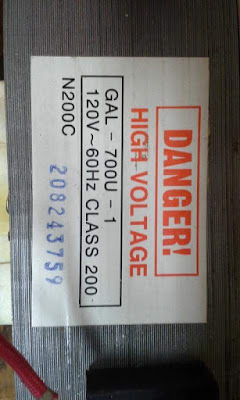I Want to See the Sun (Chromatically Abberated) Part II
There is more to seeing than what meets the eyeball.
N. R. Hanson
Speaking of reducing chromatic abberation (in my last post) there is a device that actually increases it...on purpose! It's called a prism. We'll deal with sunlight, rather than the sun itself for now.
Here's a photo of an incredibly awesome prism that really separates the wavelengths of light really well. The craftsman that cut and wet sanded it is an incredible optician: me!
If the glass were perfectly, magically clear it wouldn't work as a prism. The differences in color absorption due to the refractive index, which in turn disperse the colors (breaks white light into a rainbow of its constituent colors). The speed of light changes in different media (air, water, glass) This is a dispersive prism.
If the surfaces are nicely polished and you blast a laser through it, it can act as a simple reflective prism. Lasers are a single wavelength and thus cannot be broken up into rainbows. They are one color only.
Here's my same prism with a laser blasting through it. No dispersion-no rainbow. It does refract-changes directions at an angle. This is mathematically referred to using Snell's Law and Ray Tracing (computing the angles the laser will exit a prism, or a bunch of prisms and mirrors and lasers in a huge system like a knowing where the ball will go in a pinball machine before you fire it).
So pretty, but useless? Not by a longshot!
In addition to aiming lasers (boring) you can use knowledge of dispersive refractive indices and wavelengths of light to investigate chemical properties of objects (and stars) you can see but not touch!
Above is a photo I took of a diffraction grating. It's a tiny, cheap $2 piece of plastic that disperses light. The white source light is at the top. The grating has zillions of tiny grooves that act like prisms.
What is similar to that? A compact disk, which has zillions of pits in it that do the same thing. That's why you see a rainbow on the bottom of music CDs. So I took a CD and put it in a box with a tiny slit to let on light:
This my homemade spectroscope's readout from a fluorescent light bulb. Notice how there are lots of blank spaces in between the color lines? Newer light bulbs are more like the laser than sunlight: way fewer wavelengths to disperse. Here's the cooler part: see the green line? That corresponds to the element Mercury. We now have proven that this fluorescent light bulb contains Mercury in it! We didn't even have to cut it open or touch it at all.
Astronomers point spectroscopes at stars to learn what elements are burning within them. Same exact principle.
Building a CD Spectroscope is easy. Here's a link to a nice set of instructions: https://www.cs.cmu.edu/~zhuxj/astro/html/spectrometer.html
Is there a way to take what we learned from the last post (PVC Telescope) and use it in spectroscopy? Yes, you can make a Slitless Spectrograph:
However, if you do the Ray Tracing in real life its not a straight line like my drawing above, it's like a downward curved line which is annoying to put into a box and more annoying to hook to a telescope which was my original purpose.
Anyway, I had so much fun with my homemade toys that I ordered a fancy store-bought Spectroscope from Amazon for all of $9 including postage.
The readout was identical to the ones i made, except that it has a scale to show you the actual wavelengths (in nanometers). Fancy!
On the right you can see the white nanometers scale above the colors. This is pretty even with no black missing lines, so this was probably sunlight on a nice day with no clouds.
Man has closed himself up till he sees all things
through the narrow chinks of his cavern.
William Blake
The only difference between my free CD spectroscope, my $2 diffraction grating Spectroscope and my $9 spectroscope is that the $9 one had a nanometer scale. Same readout on all.
Now, is there a device that melds spectroscopes with prisms? Yes. They're called prism spectrographs. They also make use of Snell's Law and Ray Tracing to get light to pass through a few (usually three) prisms.
In the above pic notice the trapezoid formed by 3 prisms smooshed together. The scribbling is me feebly trying to start figuring out what shape prisms I needed to grind. I wrote "Snell's Law" but it's just part of calculating total internal reflection. I wisely decided manual Ray Tracing would be easier: shine a laser through the prisms and see where it goes, which is what the red laser photo at the beginning of this post shows...so finally, for the first time in human history lasers actually did something useful: lasers kept me from having to calculate inverse trigonomic functions for the angles of incidence.
As an aside, in not bothering with Snell's Law (named after a guy named Snellius but discovered by Ibn Sahl in the 900s) and playing with Ray Tracing I can also find and deal with any bits of light that doesn't confirm to Snell's Law. Specifically: Newton Rings!
An even weirder aside: Hooke was the first to build a Gregorian Reflector Telescope. It was designed (by James Gregory) before another guy built a reflector telescope, but wasn't made until a little after the other guy did, which is why most reflector telescopes are now called Newtonian Reflectors. Yep, good old Issac cheated Hooke yet again! Gregorian telescopes still mostly survive in very nice, easy to design and build Schmidt-Cassegrain telescopes. Isaac Newton did invent calculus all by himself, or at least he claimed to have done so a few years after Gottfried Leibniz published a paper on the new math of calculus he (Leibniz) invented. In fact we still use Leibniz notations to this day!
Newton is often quoted, "If I have seen further it was because I was standing on the shoulders of giants." This would seem to be a fair acknowlegement and reconciliation-except that he ripped that quote off from Bernardus Carnotensis. Newton: pickpocket of science.
Is that all? Not by a long shot! In addition to identifying burning elements in laboratories and in stars you can do something else with a spectroscope. Calculate Radial Velocity! If an object space shows a slight increase in red wavelengths it is receding away from us, blue means it's floating towards us! Neat. It is the color wavelength version of The Doppler Effect for sound waves. A passing police car's siren is high pitched when it's coming at you and then goes to a lower pitch (at least it seems to for you) as it passes.
As the car approaches and passes you standing still:
eeeeeeeeee-aaaaaaahhhh.
To the police officer in the car the siren doesn't change pitch: eeeeeeeeeeeeeeeeeeeeeee.



















































